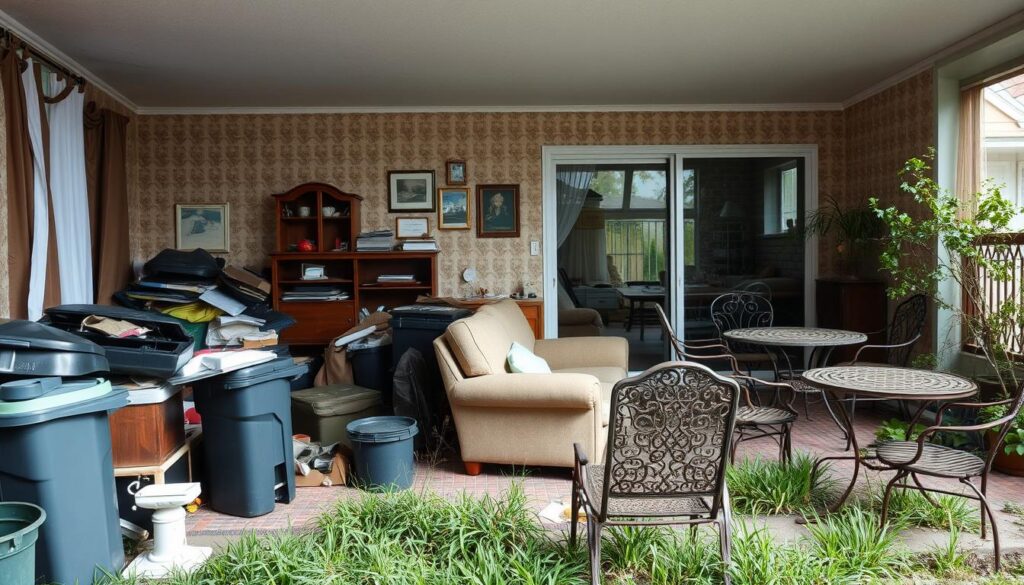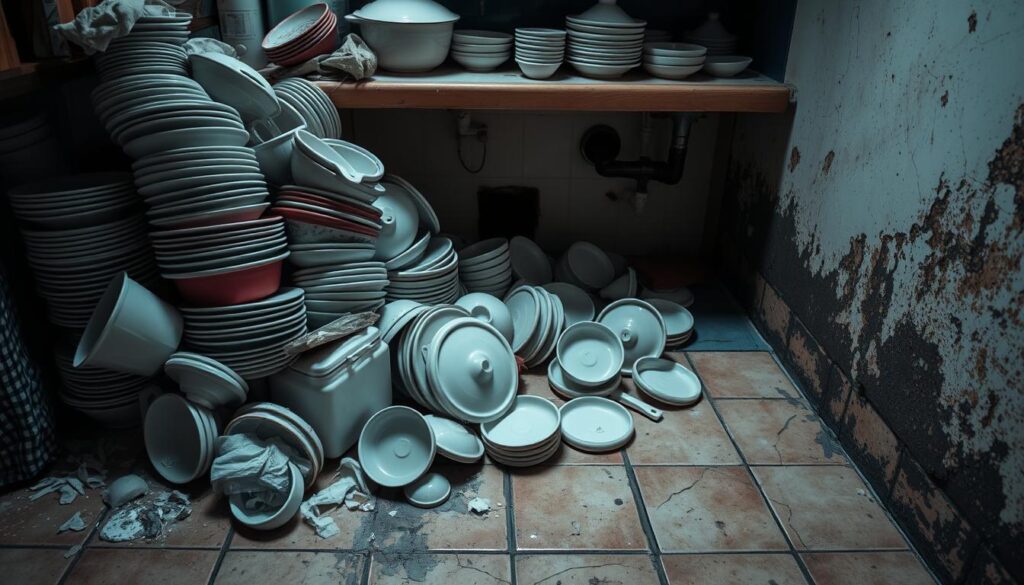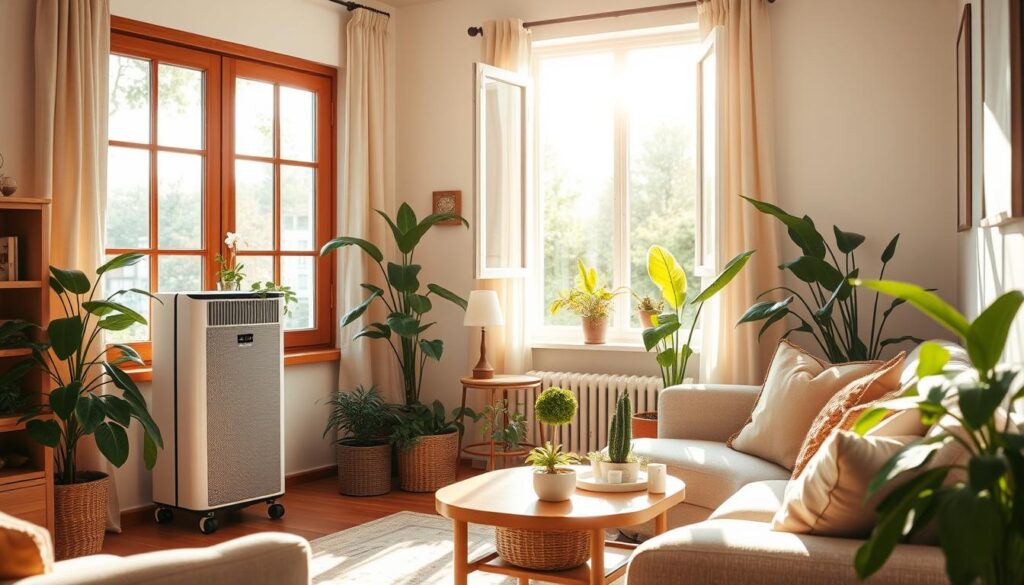Ever walked into a home that just didn’t feel right? Maybe it was the messy exterior, the cluttered interior, or the old decor. These small details can greatly affect how people see your home. As a real estate agent, I’ve seen many mistakes – from bad landscaping to messy renovations. But, with some effort and focus on details, you can make your home a hit with everyone.

Key Takeaways
- Curb appeal is crucial for making a great first impression on potential buyers
- Clutter and disorganization can make a home feel uninviting and overwhelming
- Outdated or mismatched decor can make a home feel stuck in the past
- Poor functionality and maintenance issues can be major turnoffs for buyers
- Offensive odors and air quality concerns can be a dealbreaker
Curb Appeal: The First Impression That Counts
The exterior of your home is the first thing people see. It can make or break their first impression. Neglecting your landscaping and letting your home look unkempt can turn off buyers. Also, outdated exterior paint and trim can make your house look old and poorly maintained, hurting its curb appeal.
Neglected Landscaping and Exterior Upkeep
A well-maintained landscape can greatly improve your home’s curb appeal. Regular lawn mowing, bush trimming, and weed removal can make your home look polished and inviting. Make sure your walkways and driveway are clean. Adding colorful flowers or decorative plants can also enhance the first impression.
Outdated Exterior Paint and Trim
Outdated exterior paint and trim can make your home look neglected. If your home’s exterior looks worn or faded, it might need a fresh coat of paint or updated trim. A modern, harmonious color scheme can give your home a new look and improve its curb appeal.
“Curb appeal is crucial for making a great first impression and attracting potential buyers. Homeowners who neglect their home’s exterior do so at their own peril.”
By fixing these common issues, you can improve your home’s curb appeal. This makes your home welcoming and attractive to potential buyers or visitors. Investing in your home’s exterior upkeep is a smart move to increase its value and appeal.
Mistakes That Make People Hate Your House
First impressions are key when selling a home. Many homeowners make mistakes that turn off buyers. Clutter, outdated decor, and maintenance issues are common deal breakers.
Home design flaws can be a big problem. Poor floor plans and outdated layouts can frustrate buyers. Also, neglecting the outside can make a bad first impression.
Clutter and chaos inside the home are major turn-offs. Overcrowded rooms and disorganization can make a space feel unwelcoming. Homeowners need to tackle these issues to make their home inviting.
Outdated decor is another big issue. Dated wallpaper and mismatched colors can make a home seem old-fashioned. Fixing these design flaws can greatly improve a home’s appeal.
Understanding and fixing common mistakes is key for attracting buyers. Focus on curb appeal, functionality, and timeless design. This way, you can create a home that impresses and leaves a positive mark.
“The first step in exceeding your customer’s expectations is to know those expectations.” – Roy H. Williams
Clutter and Chaos: The Enemy of Inviting Spaces
Creating a welcoming home is key, but clutter and chaos can stop it. Buyers want a space that’s clean, organized, and easy to live in. Overcrowded rooms and disorganization can make a home feel too much and uninviting.
Overcrowded Rooms and Lack of Organization
One big mistake is having overcrowded rooms and no organization. Too much clutter can make even big rooms feel small and unwelcoming. It’s hard for buyers to see themselves living there.
- Getting rid of unnecessary items and decluttering opens up space.
- Using smart storage, like built-in shelves, makes the most of space.
- Keeping a tidy and organized home helps buyers see themselves thriving there.
By tackling the clutter and chaos in overcrowded rooms, homeowners can make their spaces welcoming. This attracts potential buyers.
“A clean, well-maintained home with a sense of order and flow can make a lasting positive impression on potential buyers.”
Outdated and Unappealing Decor
A home’s decor greatly affects a buyer’s first impression. Elements like dated wallpaper, mismatched color schemes, and overwhelming finishes can make a house seem old. This makes it hard for buyers to imagine living there.
Stuck in the Past: Dated Wallpaper and Finishes
Outdated wallpaper and dated finishes can make a home look uninviting. These unappealing decor choices can show a lack of care. Updating these outdated decor elements can refresh a space and show its true potential.
Mismatched and Overwhelming Color Schemes
A mismatched color scheme or an overwhelming color scheme can be off-putting. It makes a room feel disjointed. Finding the right balance in colors is key to a welcoming space. A well-chosen color palette can greatly impact how buyers see the home.
“Updating outdated and unappealing decor elements can significantly improve a home’s overall appeal and help potential buyers envision themselves living there.”
Functionality Failures: When Homes Lack Livability
When you’re looking to buy a new home, livability is key. A bad floor plan can really turn off buyers. It’s hard to see yourself living in a home that’s not laid out well.
Poor Floor Plans and Traffic Flow
Bad floor plans are a big problem in homes. Small, odd-shaped rooms or rooms that don’t connect well make a home feel tight. Also, homes with weird traffic paths, like narrow hallways, mess up the flow.
- Poorly designed floor plans that make it difficult to move through the home
- Rooms that are too small, oddly shaped, or disconnected from the living space
- Narrow hallways or dead-end corridors that disrupt the natural flow of traffic
When homes aren’t functional, they’re less appealing to buyers. Homes that are easy to get around, with good floor plans, are more attractive. They make a great first impression.
| Functionality Failures | Impact on Livability |
|---|---|
| Poor floor plans | Awkward traffic flow, difficulty navigating the space |
| Lack of storage and organization | Cluttered and cramped living environment |
| Outdated and inefficient systems | Increased utility costs and potential for breakdowns |
“A home’s functionality and livability are essential factors for potential buyers. Homes that lack functional and practical layouts may struggle to attract buyers, as they are unable to envision themselves comfortably living in the space.”
Maintenance Mishaps: The Hidden Costs
Homeowners often ignore the need for regular maintenance and quick repairs. This leads to many problems that make their homes less attractive to buyers. Issues like maintenance mishaps and deferred maintenance can scare off buyers. They don’t want to deal with neglected repairs or costly renovations.
Neglected Repairs and Deferred Maintenance
A well-kept home is a valuable asset. But, a neglected home can become a big problem. Problems like leaky faucets, old appliances, and crumbling foundations can happen if maintenance is ignored. Buyers are hesitant to buy a home that needs a lot of work. They worry about the hidden costs that can eat into their budget.
- Unfixed plumbing issues can cause water damage and mold.
- Old HVAC systems can lead to bad air quality and high energy bills.
- Ignoring roof repairs can make a home vulnerable to weather damage.

Potential buyers are cautious about homes with neglected repairs and deferred maintenance. They know there could be hidden costs and a lot of work needed. Fixing these maintenance mishaps early on can make a home more appealing. It can also increase its value and marketability.
Inadequate Storage Solutions
Homebuyers often look for homes with lots of storage. This helps them keep things tidy and their living areas neat. Sadly, many homes don’t have enough storage, like small closets or no built-in shelves or cabinets. This can really turn off potential buyers.
Not having enough storage can make a home look cluttered and messy. This can hurt the home’s appeal, especially in older homes or those with old designs. These homes might not meet today’s storage needs. Homeowners who don’t fix these storage issues might find their homes hard to sell. Buyers want homes that are neat and organized.
- Inadequate closet and cabinet space
- Lack of built-in shelving or storage solutions
- Outdated or inefficient storage systems
To solve these inadequate storage solutions, homeowners can try creative storage ideas. They can install custom closet systems, add built-in bookcases or cabinets, or use unused areas for storage. Fixing these storage problems can make a home more functional and appealing. This makes it more attractive to buyers.
“A well-designed home should have a place for everything, and everything in its place.”
By focusing on storage and keeping things organized, homeowners can make their homes more welcoming. This can attract potential buyers and help the home stand out in a crowded market.
Offensive Odors and Indoor Air Quality Concerns
Unpleasant smells can scare off potential homebuyers. Issues like pet odors, stale smoke, or musty smells can leave a bad taste. Fixing these problems is key to making your home welcoming.
Poor indoor air quality is not just a nuisance. It can also harm your health. Pollutants and allergens in the air can lead to breathing problems. Keeping your home’s air clean is important for your family’s health.
| Causes of Offensive Odors | Strategies for Improved Indoor Air Quality |
|---|---|
| Pet odors Smoke residue Mold and mildew Trash and garbage Poor ventilation | Thoroughly clean and deodorize carpets, fabrics, and surfaces Invest in air purifiers and ventilation systems Eliminate sources of moisture and control humidity levels Properly dispose of waste and maintain a clean environment Consider professional duct cleaning and HVAC maintenance |
Fixing offensive odors and indoor air quality concerns can greatly improve your home. By getting rid of bad smells and ensuring a healthy environment, you make your home more appealing. This will leave a good impression on anyone who visits.

“A clean, well-maintained home not only looks more inviting but also promotes better health and well-being for its occupants.”
Questionable Renovations and DIY Disasters
Poorly done home renovations or DIY projects can really turn off buyers. Bad work, low-quality materials, and obvious mistakes make a home look unprofessional. It’s hard for buyers to see the home’s real potential.
Botched Home Improvement Projects
From quick remodels to amateur electrical work, bad home improvement projects leave a bad mark. Buyers see these as warning signs, fearing the costs and trouble of fixing them. Questionable renovations and DIY disasters can make a home less appealing, making buyers question its quality and care.
Trying to do big projects without the right skills can lead to DIY disasters that cost a lot to fix. Bad plumbing, structural changes, or a messy paint job can make a home seem neglected. Buyers might not want to deal with these issues, opting for a home that’s ready to move into.
- Shoddy workmanship and subpar materials
- Evident mistakes that undermine the home’s potential
- Concerns about hidden costs and hassle of fixing problems
- Perception of neglect or mismanagement
- Buyer reluctance to take on burden of botched projects
Energy Inefficiency and High Utility Costs
Many people worry about energy inefficiency and high utility costs when buying a home. Homes that don’t use energy well can lead to high bills. This adds a big financial stress for new owners.
Fixing energy efficiency issues can make a home more attractive and valuable. Upgrading to energy-efficient systems can lower monthly bills. It also helps the environment.
Identifying Energy Inefficiency
Poor insulation, old HVAC systems, and inefficient appliances cause energy waste. Buyers might hesitate to buy a home needing expensive fixes for better energy use.
- Check the home’s insulation in the attic, walls, and crawl spaces.
- Look at the age and condition of the HVAC system, water heater, and big appliances.
- Find drafts and air leaks around windows, doors, and other spots.
The Benefits of Energy-Efficient Upgrades
Energy-efficient upgrades make a home more appealing and save money on bills. Improvements like energy-efficient windows, better insulation, and efficient HVAC systems boost a home’s energy use.
| Upgrade | Potential Energy Savings | Average Cost |
|---|---|---|
| Insulation Upgrade | 10-20% less on heating/cooling costs | $1,500 – $3,500 |
| ENERGY STAR® Windows | 7-15% less on heating/cooling costs | $3,000 – $8,000 |
| High-Efficiency HVAC System | 15-30% less energy use | $4,000 – $12,000 |
By fixing energy issues and upgrading, homeowners can make their homes more efficient and cost-effective. This makes them more appealing to buyers.
Conclusion: Creating a Welcoming and Desirable Home
Homeowners can turn their homes into welcoming places by avoiding common mistakes. Improving the curb appeal and fixing functionality and maintenance issues are key. These steps can make the home more attractive and valuable to buyers.
Keeping the exterior clean and updating the paint can make a great first impression. A clutter-free and organized home also helps. Choosing timeless decor and fixing any issues can boost the home’s appeal. Adding energy-efficient features and improving air quality can also attract buyers.
By fixing these common mistakes, homeowners can make their homes stand out. A well-planned approach and attention to detail can lead to a successful sale. This makes the home more inviting and valuable.
FAQ
What are some common mistakes that can make people hate a house?
Some common mistakes include neglecting curb appeal and using outdated paint. Too much clutter and disorganized spaces also turn off buyers. Dated decor, poor floor plans, and deferred maintenance are other issues.
Not enough storage, bad smells, and shoddy DIY projects can also harm a home’s appeal.
How important is a home’s curb appeal in making a good first impression?
A home’s exterior is the first thing buyers see. It can make or break their first impression. Neglected landscaping and unkempt exteriors can immediately turn off buyers.
Outdated paint and trim can also make a house look old and poorly maintained.
How can clutter and chaos impact a home’s inviting atmosphere?
Too much clutter and disorganization can make a space feel cramped and uninviting. It’s hard for buyers to see themselves living there. Overcrowded rooms and lack of organization can overwhelm buyers.
What types of outdated and unappealing decor can negatively affect a home’s appeal?
Dated wallpaper, finishes, and mismatched colors can make a house feel tired. It’s hard for buyers to imagine living there.
How can poor functionality and lack of livability turn off potential buyers?
Poorly designed floor plans can create awkward traffic flow. This can be a major turnoff for buyers. Homes with impractical layouts struggle to attract buyers.
What are some of the hidden costs associated with maintenance mishaps?
Neglected homes can deter buyers due to the need for repairs. Buyers are often wary of properties needing extensive work. This can strain their budgets.
How can inadequate storage solutions impact a home’s appeal?
Buyers value homes with ample storage space. It helps keep belongings organized and living areas clutter-free. Homes lacking storage solutions can be a major turnoff.
What types of offensive odors and indoor air quality concerns can deter potential buyers?
Unpleasant odors and poor air quality can deter buyers. Homeowners should address any lingering smells and ensure clean air. These factors can leave a lasting negative impression.
How can questionable renovations and DIY disasters impact a home’s appeal?
Poorly done renovations or DIY projects can be a major turn-off. Shoddy workmanship and evident mistakes can make a home feel unprofessional. It’s hard for buyers to see the home’s true potential.
How can energy inefficiency and high utility costs affect a home’s desirability?
Homes with poor energy efficiency and high utility costs are a concern. Buyers may avoid homes with expensive energy bills. Fixing energy efficiency issues can make a home more appealing.



